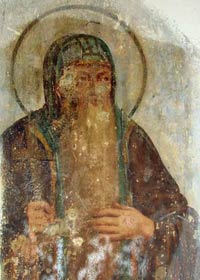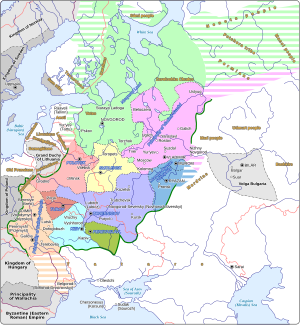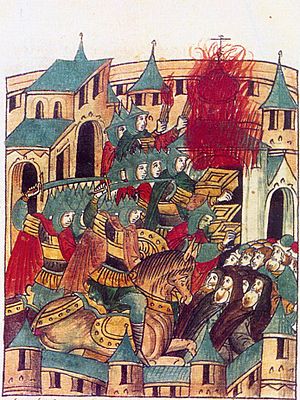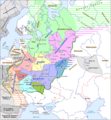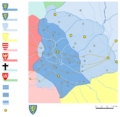Michael of Chernigov facts for kids
Mikhail Vsevolodovich (born around 1185 – died September 20, 1246), also known as Michael of Chernigov, was an important prince in Kievan Rus'. He ruled as Grand Prince of Kiev (1236–1239; 1241–1243) and also held titles like Prince of Pereyaslavl (1206), Novgorod-Seversk (1219–1226), Chernigov (1223–1235; 1242–1246), Novgorod (1225–1226; 1229–1230), and Galicia (1235–1236).
During his time, towns in Chernigov became very rich. This suggests that Michael worked hard to help trade grow. He wanted to control important cities like Halych and Kiev because they were major routes for goods coming from places like the Rhine valley and Hungary to Chernigov. He also made trade deals and alliances with the Poles and the Hungarians. In Novgorod, he lowered taxes for the people and gave more political freedom to the local nobles, called boyars.
Michael faced a huge challenge during the Mongol invasion of Kievan Rus' (1237–1242). He was defeated and had to run away. Sadly, in 1246, he was executed by Batu Khan, the leader of the Mongols.
Quick facts for kids Michael of Chernigov |
|||||
|---|---|---|---|---|---|
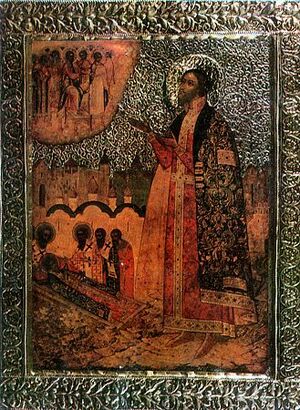
Icon of Saint Michael of Chernigov, 17th century
|
|||||
| Prince of Chernigov | |||||
| Reign | 1223–1235; 1242–1246 | ||||
| Predecessor | Mstislav II Svyatoslavich Mstislav III Glebovich |
||||
| Successor | Mstislav III Glebovich Roman Mikhailovich |
||||
| Grand Prince of Kiev | |||||
| Reign | 1236–1239; 1241–1243 | ||||
| Predecessor | Yaroslav II of Vladimir Daniel of Galicia |
||||
| Successor | Daniel of Galicia Yaroslav II of Vladimir |
||||
| Born | c. 1185 | ||||
| Died | 20 September 1246 (age 60-61) | ||||
| Spouse | Elena Romanovna | ||||
| Issue | Feodula Rostislav of Macsó Maria Roman of Chernigov and Bryansk Mstislav of Karachev and Zvenigorod Simeon of Glukhov and Novosil Yury of Torusa and Bryansk |
||||
|
|||||
| House | Olgovichi | ||||
| Father | Vsevolod IV of Kiev | ||||
| Mother | Anastasia of Poland | ||||
Life Story of Michael of Chernigov
Early Years and Challenges
Michael was the only known son of Prince Vsevolod Svyatoslavich. His mother was Anastasia, daughter of Duke Casimir II of Poland. Michael likely grew up in his father's family lands in the northwest.
When Michael was a child, he suffered from a serious illness that made him unable to move. His grandfather, Grand Prince Svyatoslav III Vsevolodovich, spent a lot of money on churches, hoping for a cure. Finally, he heard about a holy man named Nikita who lived in a monastery.
Prince Svyatoslav rode to the monastery with his nobles (boyars). Nikita gave his staff to a boyar to take to Michael. When Michael touched the staff, he was cured and could walk! He then went to Nikita for a blessing. After his cure, Michael gave a generous gift to the monastery. He also ordered a stone cross to be built where he was healed. This story, though old, seems to have some truth to it.
In 1206, Michael's father took control of Kiev. He gave the town of Pereyaslavl to Michael. However, another prince, Rurik Rostislavich, quickly took Kiev back. Michael, with only a small group of followers, had to leave Pereyaslavl and return to his father in Chernigov. His father tried to take Kiev again in 1207 but was driven out a second time. Michael was with his father during these events.
Michael married Elena Romanovna (or Maria Romanovna) around 1210 or 1211. She was the daughter of Prince Roman Mstislavich of Halych.
In 1212, Michael's father lost Kiev for the third time and fled to Chernigov, where he died. Michael likely inherited some lands like Bryn, Serensk, and Mosalsk from his father. Later, Michael probably became the prince of Novgorod-Seversk.
Facing the Mongol Threat
In the spring of 1223, a strong Mongol army entered the lands of the Cumans. The Cumans fled to Rus' and warned the princes that they needed help. The Rus' princes decided to attack the Mongols in the Cuman steppes. Michael also attended this meeting. The Rus' forces went down the Dnieper river. In an early fight, one Rus' prince managed to defeat a small group of Mongols.
After crossing the Dnieper, the armies marched for eight days. They then met the main Mongol force at the Kalka River. The Rus' army was not united, and the battle was a disaster. Most princes, including Michael's uncle, died in the fight. Michael was likely among the first survivors to return to Chernigov.
Prince of Chernigov and Novgorod
After his uncle's death, Michael became the prince of Chernigov. He took control of many territories, making him a very powerful landowner.
At this time, the people of Novgorod often disagreed with the Grand Prince of Vladimir. In 1225, they agreed to accept Michael as their prince. Michael worked to get back goods that had been taken from Novgorod merchants. He also invited Novgorod merchants to Chernigov, promising that their lands would be like one. After a while, Michael left Novgorod, and the people asked another prince to rule them.
Around 1227, Michael was involved in a family dispute with Oleg Svyatoslavich. Other princes and even the head of the church helped them make peace.
In 1228, Michael joined Grand Prince Vladimir III of Kiev to attack Michael's brother-in-law, Prince Daniil Romanovich. They tried to capture a town called Kamenets but failed.
In 1229, the people of Novgorod again asked Michael to be their prince. He arrived in May and helped them make changes to weaken the power of another prince. Michael allowed local nobles to appoint their own judges. He also removed a special tax on churches and lowered taxes for common people. After about three months, Michael returned to Chernigov. He left his son, Rostislav Mikhailovich, in charge of Novgorod.
In 1230, Michael returned to Novgorod and put his son on the throne. However, the Novgorodians soon forced Rostislav to leave. This was the last time Michael's family ruled Novgorod.
Prince of Chernigov and Grand Prince of Kiev
In 1231, Michael fought against Grand Prince Vladimir III of Kiev. Daniil Romanovich helped Vladimir, but he later helped make peace between them.
In 1235, Vladimir Rurikovich and Daniil Romanovich attacked Chernigov. Michael promised Daniil many gifts if he would leave Vladimir. Daniil agreed, but Michael then attacked Daniil's troops by surprise, defeating them.
Michael then joined forces with Iziaslav Vladimirovich and the Cumans. They defeated Vladimir Rurikovich and Daniil Romanovich near Torchesk. Michael's allies took Kiev, and he appointed a prince to rule there.
Later, Michael took control of Halych. In 1236, he attacked Daniil Romanovich in Volhynia with a large army. He also got help from his uncle, Duke Konrad I of Masovia. However, the Cumans plundered the lands, forcing Michael to stop his campaign.
King Béla IV of Hungary agreed to help Michael. Daniil Romanovich tried to take Halych, but Michael defended it. Michael later gave the town of Przemyśl to Daniil to make peace.
Meanwhile, other princes took Kiev from Michael's appointed ruler. Michael then came to Kiev and took it without a fight. He and his son then took Przemyśl back from Daniil. However, the people of Halych later invited Daniil Romanovich to rule them, and Michael's son fled.
The Mongol Invasion
In the winter of 1237, Batu Khan and the Mongols reached the lands of Ryazan. Prince Yury Ingvarevich of Ryazan may have asked Michael for help, but Michael sent no troops. On December 21, the Mongols took Ryazan.
In March 1238, the Mongols defeated and killed Grand Prince Yuri II Vsevolodovich. They then attacked the town of Kozelsk, fighting for seven weeks to capture it. Michael's own lands, Mosalsk and Serensk, also suffered greatly.
The second part of the Mongol invasion began in early 1239. On March 3, a Mongol group took Pereyaslavl. Michael then went to Kamenets and tried to move his people out of Kiev. However, another prince, Yaroslav Vsevolodovich, attacked Kamenets, captured Michael's wife, and took many goods. Michael escaped and returned to Kiev. When Daniil Romanovich learned his sister (Michael's wife) was captured, he asked Yaroslav to send her to him.
In the autumn of 1239, the Mongols took Chernigov. They sent messages to Kiev, offering peace, but Michael refused. In 1240, Batu Khan sent Möngke to check out Kiev. When the Mongols sent messengers again, Michael bravely refused to surrender and even had them killed. Michael could only rely on his own soldiers and the Kiev army, so he fled to Hungary.
In Hungary, Michael tried to arrange a marriage for his son, Rostislav, with the king's daughter. But King Béla IV saw no benefit in this alliance and sent Michael and his son away. Michael then went to his uncle in Mazovia, who welcomed him. Michael decided to make peace with his brother-in-law, Daniil Romanovich. He promised not to fight Daniil or try to take Halych again. Daniil invited him to Volhynia, returned his wife, and gave him control of Kiev. However, Michael did not return to Kiev because of the Mongol threat.
In late 1240, Batu Khan surrounded Kiev, and the city fell on December 6. Learning this, Michael left Volhynia and again sought help from his uncle. When the Mongols also threatened Mazovia, Michael traveled west to Wrocław in Silesia. Along the way, his group was attacked, and some of his people, including his granddaughter, were killed. After the Mongols passed through, Michael returned to Mazovia.
Final Years and Martyrdom
In the spring of 1241, Michael felt it was safe to return home. He stopped at the ruined town of Volodymyr, then traveled to Pinsk, and finally to Kiev. He could not return to his old court, so he lived on an island near the city. The Mongols did not stop him, showing they allowed some princes to return to their damaged towns.
In 1242, Michael learned that King Béla IV had married his daughter to Michael's son, Rostislav. Michael thought this meant his alliance with the Hungarian royal family was finally happening. He went to Hungary, expecting to make important agreements. However, the king and his son turned him away. Michael was very angry with his son and returned to Chernigov empty-handed.
Meanwhile, Batu Khan ordered all princes to visit his capital, Sarai, and show him respect. Prince Yaroslav Vsevolodovich of Suzdal was the first to go. In 1243, Batu Khan made him the senior prince in Rus'. Yaroslav then sent his commander to rule Kiev. Because of this, Michael left Kiev and returned to Chernigov. But even there, his power was not secure. Like all other Rus' princes, he needed Batu Khan's permission to rule his lands.
By the end of 1245, Michael was one of the few senior princes who had not yet bowed to the Mongols. He decided to go to Sarai to prevent a Mongol attack on his lands. His grandson, Boris Vasilkovich, went with him.
When they arrived at Sarai, Batu Khan's messengers told Michael to worship according to the Mongol customs, by bowing to fires and idols. Michael agreed to bow to the khan but refused to worship idols, saying it was wrong for a Christian. Batu Khan was reportedly furious and ordered Michael to be killed. Michael was executed by Doman of Putivls, and his noble, Fedor, was killed after him.
Michael's Legacy
The Story of His Life
A special story about Michael's life, called a vita, was written after his death. It describes his life in detail and presents his execution as a martyrdom. This story helped people remember him as a saint.
Carpine's Account
Giovanni da Pian del Carpine, a church leader who traveled through Kievan Rus' in the 1240s, wrote about Michael's death. He said that when Michael came to see Batu Khan, the Mongols first tried to make him walk between two fires. Then they told him to bow south to Genghis Khan. Michael said he would gladly bow to Batu but not to the image of a dead man, because it was wrong for a Christian.
When Michael kept refusing, Batu ordered him killed. Michael was trampled on until he died. He comforted one of his soldiers, saying, "Be strong because your punishment will not last long, and then at once eternal joy will follow." After this, Michael's head was cut off. The soldier was also killed.
Honored as a Saint
People in Rus' saw Michael and Fedor as martyrs right after they died. Their bodies were later brought to Chernigov and buried in a special chapel in the Holy Saviour Cathedral.
Michael's wife and daughters helped spread his story. His daughter Maria and her sons started a special day to honor them, September 20. They also built a church in their honor.
The church officially recognized Michael as a saint in 1547. When the Poles took Chernigov in 1578, Ivan IV the Terrible moved Michael's holy remains to Moscow. There, they were placed in the cathedral of Saint Michael the Archangel. Many Russians have seen these martyrs as special helpers before God, especially during difficult times.
Historians say that Michael of Chernigov was the last truly independent senior prince of Kiev. He was not defeated by another prince but by the powerful Mongols. Before the Mongol invasion, he was one of the strongest princes. Some have said he failed to unite the princes against the invaders, but others argue this was an impossible task. Michael is seen as the first prince from his family (the Olgovichi) to become a martyr for his Christian faith. He and Fedor became known as "The Passion-Sufferers of Chernigov" and "The Miracle-Workers of Chernigov."
Family Tree
Marriage and Children
Michael married Elena Romanovna (or Maria Romanovna) around 1210 or 1211. She was the daughter of Prince Roman Mstislavich of Halych. They had several children:
- Feodula Mikhailovna (1212 – 1250); she became a nun named Evfrosinia.
- Duke Rostislav Mikhailovich of Macsó (born around 1225 – died 1262).
- Maria Mikhailovna (died December 7 or 9, 1271), who married Prince Vasilko Konstantinovich of Rostov.
- Prince Roman Mikhailovich of Chernigov and Bryansk (born around 1218 – died after 1288/1305).
- Prince Mstislav Mikhailovich of Karachev and Zvenigorod (1220 – 1280).
- Prince Simeon Mikhailovich of Glukhov and Novosil.
- Prince Yury Mikhailovich of Torusa and Bryansk.
Ancestors
| Ancestors of Michael of Chernigov | |||||||||||||||||||||||||||||||||||||||||||||||||||||||||||||||||||||||||||||||||||||||||||||||||||||||||||||||||||||||||||||||||||||||||||||||||||||||||||||||||||||||||||||||||||||||||||||||||||||||||||||||||||||||||||||||||||||||||||||||||||||||||||||||||||||||||||||||||||||||||
|---|---|---|---|---|---|---|---|---|---|---|---|---|---|---|---|---|---|---|---|---|---|---|---|---|---|---|---|---|---|---|---|---|---|---|---|---|---|---|---|---|---|---|---|---|---|---|---|---|---|---|---|---|---|---|---|---|---|---|---|---|---|---|---|---|---|---|---|---|---|---|---|---|---|---|---|---|---|---|---|---|---|---|---|---|---|---|---|---|---|---|---|---|---|---|---|---|---|---|---|---|---|---|---|---|---|---|---|---|---|---|---|---|---|---|---|---|---|---|---|---|---|---|---|---|---|---|---|---|---|---|---|---|---|---|---|---|---|---|---|---|---|---|---|---|---|---|---|---|---|---|---|---|---|---|---|---|---|---|---|---|---|---|---|---|---|---|---|---|---|---|---|---|---|---|---|---|---|---|---|---|---|---|---|---|---|---|---|---|---|---|---|---|---|---|---|---|---|---|---|---|---|---|---|---|---|---|---|---|---|---|---|---|---|---|---|---|---|---|---|---|---|---|---|---|---|---|---|---|---|---|---|---|---|---|---|---|---|---|---|---|---|---|---|---|---|---|---|---|---|---|---|---|---|---|---|---|---|---|---|---|---|---|---|---|---|---|---|---|---|---|---|---|---|---|---|---|---|---|---|---|---|
|
|||||||||||||||||||||||||||||||||||||||||||||||||||||||||||||||||||||||||||||||||||||||||||||||||||||||||||||||||||||||||||||||||||||||||||||||||||||||||||||||||||||||||||||||||||||||||||||||||||||||||||||||||||||||||||||||||||||||||||||||||||||||||||||||||||||||||||||||||||||||||
Descendants and Later Families
The "upper princes" who ruled the Upper Oka Principalities in the 14th and 15th centuries were all descendants of Michael Vsevolodovich of Chernigov.
Many important noble families in the 19th century came from Michael's line. These include the Baryatinsky, the Gorchakovy, the Dolgorukie, the Eletskie, the Zvenigorodskie, the Koltsovy-Mosalskie, the Obolenskie, the Odoevskie, and the Shcherbatovy families.
Images for kids


